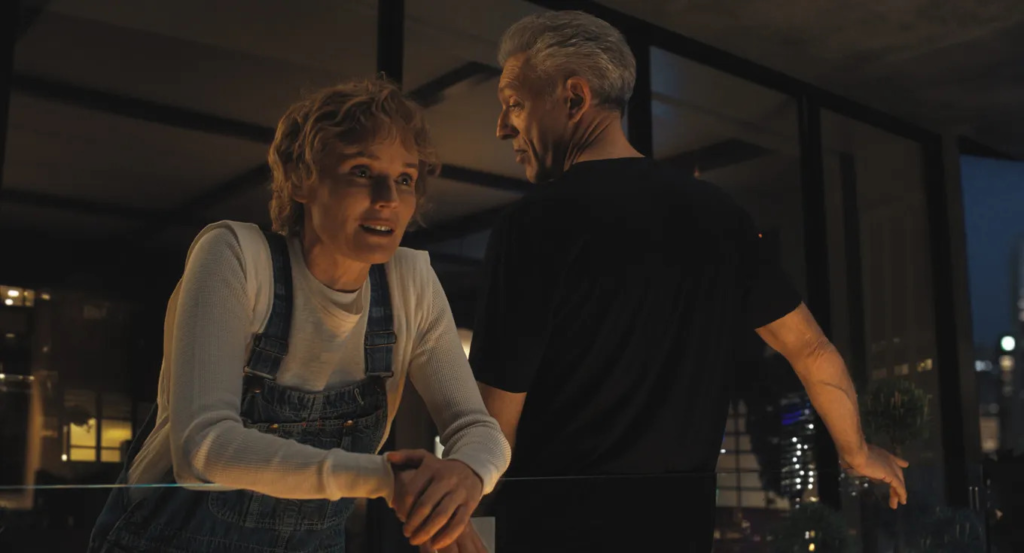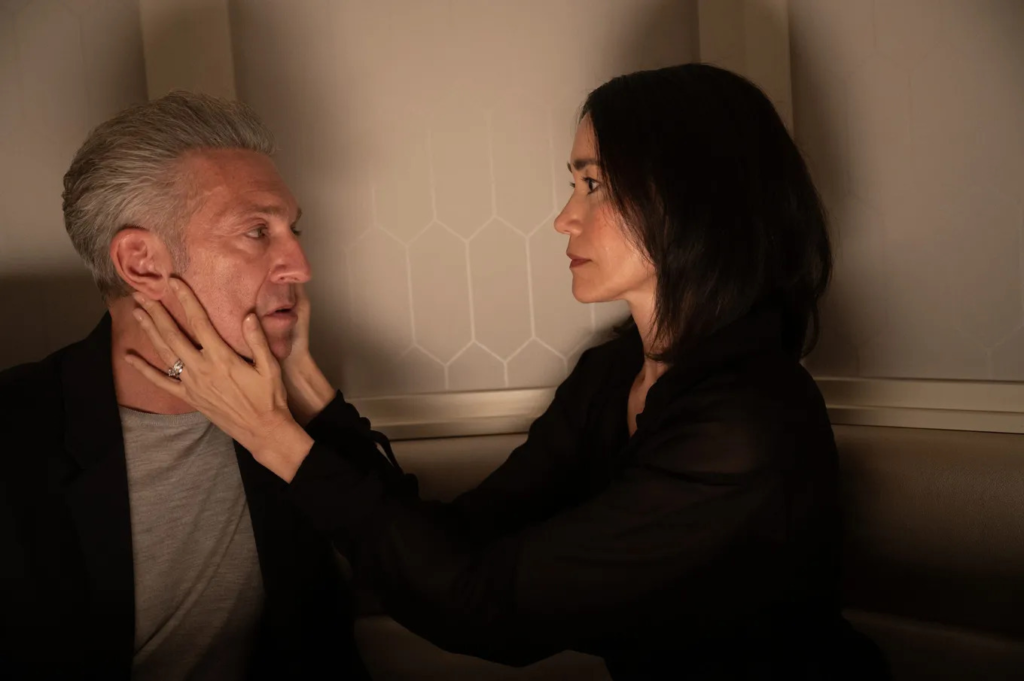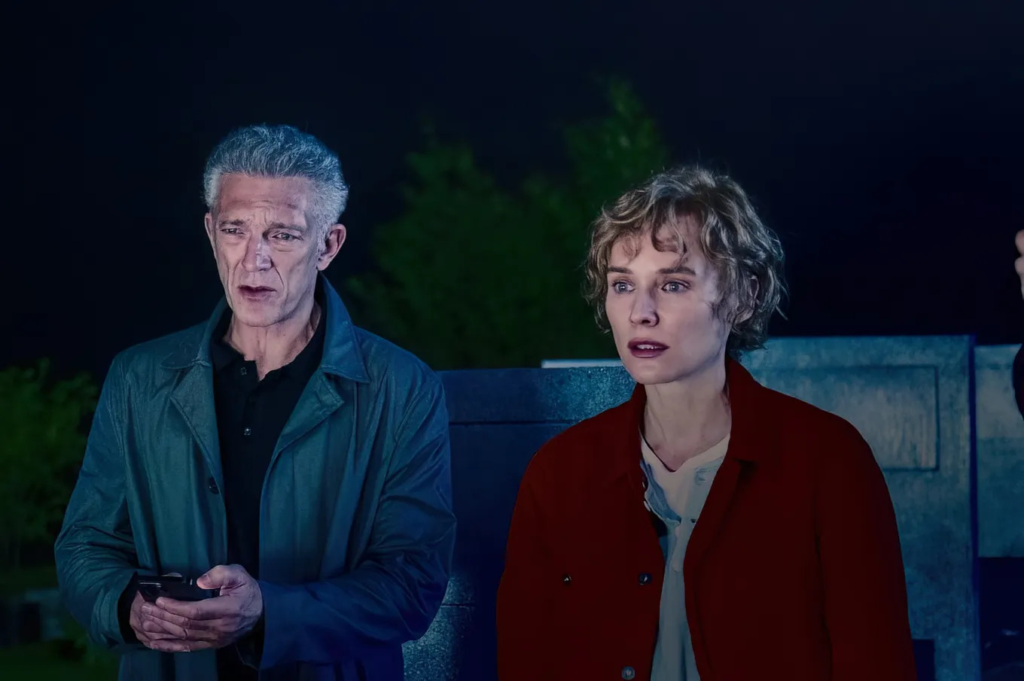Director: David Cronenberg
Writer: David Cronenberg
Stars: Vincent Cassel, Diane Kruger, Guy Pearce
Synopsis: Karsh, an innovative businessman and grieving widower, builds a device to connect with the dead inside a burial shroud.
In David Cronenberg’s world, everything is tangible, from his plastic, carnal creations to his characters’ emotions deep inside their hearts, even when the narrative seems somewhat distant from reality. You can grasp everything in his mind the same way you have dreams and nightmares about David Lynch’s oeuvre. Cronenberg does many things with the body, but his films also haunt the mind and soul of the viewer – his career is divided into those two halves – which traverses them into a state of shock and awe. And it is an experience like no other. He has often tested Cannes Film Festival attendees with these distinct, disturbing experiences that yield them until numb. In his latest work, The Shrouds, the Canadian filmmaker has done it again.

David Cronenberg has decided to retain the mysteriousness and eroticism prevalent in his cinema while being more restrained in his horror elements and inquisitive prodding. It is one of his most refined works, cut from the same cloth as what came before, yet with a different, more intimate pattern. Switching the grisly for the abstruse and philosophical, The Shrouds is Cronenberg’s most contemplative work to date, using the grief he still holds after the death of his wife of forty-three years, Carolyn (who passed away in 2017 after battling cancer), to create a story about our own conspiracies while dealing with loss – our search for answers as we’re in our mourning processes.
He draws from his own life – the lead, Vincent Cassel, mirroring his image and persona to offer a glance into the filmmaker’s psyche and soul – and pain to curate an intentionally estranged and cold atmosphere so the viewer can sense, both in front and behind the camera, that lingering dread that has haunted every one of us who have been struck with the death of a person held dear. This is all seen through the eyes of the melancholy-drowned Karsh (Cassel, or, to put it in Cronenbergian terms, the director’s dead ringer), who yearns and longs to be next to his passed wife, Beca (Diane Kruger in one of three roles). Karsh cries for her and yells to the void to have her back.
You see how Karsh’s insides are gnawed, but, on the outside, there’s no abreaction. There’s no emotional release. Visions about her continue to haunt him to the point of being fixated on her presence. These necrophilic nightmares, not in the way that Jorg Buttgeirat did in the cheap sleaze that is Necromantik, about his wife, serve as some more tactile exploration into Karsh’s psyche. He sees the image of the past he’s holding onto in his mind and the decomposing one he can see via his skeptical technological creation. He has founded a revolutionary and provocative gadget called GraveTech. This company allows people to grieve in a different, more tangible manner by putting cameras in the burial so they can see a clear image of their loved ones.

The headstones, a connective tissue between life and death, demonstrate the body’s materiality. This image of a body without a beating heart being readily available at all times, rotting as time passes, adds another layer. Cronenberg, known for deconstructing and reconstructing the body, explores with this new technology how we tend to hold onto that perfect image of a person once they are gone. However, he does so uniquely, where both the rotting flesh and youth intertwine, creating a potent coldness that puts chills down the viewer’s spine. In this world where Karsh is doing acts that service his emotions, the body, now ridden with everything human, comes as an everlasting image that stains and relives.
Just as the body turns inside out, Karsh’s obsession increases; his world revolves around that shroud—that vision planted in his mind that time destroys while he remains wounded yet enamored. Even when he matches with a woman on a dating service, he brings her close to the memory of his passed wife; they walk around the graves and bask in what is left – to quote Eva H. D.’s poem ‘Bonedog’: “Everything you see now, all of it… bone.” Even through these perilous thoughts across his mind, Karsh remains calm, as if nothing fazes him. This calmness maintains him as a complex, meditative character we want to dissect.
We all have had to put on a poker face during our worst times. But Karsh doesn’t seem to have one; he just wanders lost in life at this point, staggered and impenetrable. He goes to the void and awaits a response; in his visions, Beca comes up with some answers that leave Karsh meditative. However, everything begins to change once the cemetery is broken into and vandalized; a hacker has also blocked the images from the corpse. Who is trying to do the deed? Is it someone who is against what Karsh has created? Or is it just a person tired of seeing people like him remain broken? He enlists the help of his brother-in-law, Maury (Guy Pierce), so they can find the culprit.
This creates a conspiracy theory about why this has happened, reflecting on how we, while facing grief, turn to plays of deception and neglect to make sense of something deemed untenable. We create alternate realities and conclusions to try to make sense of life’s biggest hardship, death. Instead of looking for answers, we ignore our realities for a second as we riddle ourselves with questions about every single detail, action, and choice as a coping mechanism. Sometimes it works, sometimes it doesn’t. But grief is something that everybody goes through differently – depending on our fears about the great beyond and how attached we were to the person. David Cronenberg comments on topics that translate from his decade’s worth of material, like sex, the rise of technology (and our dependence on it), and artificial intelligence.
Cronenberg does so via his usual visually hypnotizing measures. However, those are the crucial focus this time, even though they are very present in the film. The Shrouds is not precisely autobiographical, but it uses many details in the director’s life to forge a compelling, spine-chilling story. Cronenberg doesn’t just translate real-life situations into the canvas. Cinematographer Douglas Koch, who worked on Crimes of the Future, highlights the light lurking within the darkness, even when the atmosphere is most opaque. This is reflected in a more literal manner when Karsh gazes up his cemetery at night, with the screen lighting up as beacons of the love we had for our dearly departed – which is a powerful image that is quite angelic in its Cronenbergian way – and the visions he has about his wife.

There’s a luminescent glow amidst the decomposing flesh. Yet, the dark shadows of melancholy continue to march on every scene, creating that fight between light and darkness, life and death (or even isolation and companionship) that’s so incredibly moving in a way that you can’t experience with the rest of Cronenberg’s work. Some narrative swings might not work in their totality, especially when the exposition dumps are on and about. However, the conspiracy theory element has many philosophical layers to peel that intrigue you, and later perturb, about his cinematic approach to healing his wounded soul. It is fascinating to see how these nihilistic scenarios have a duality, like a mirroring effect that coats the film in a shroud of its own, where Cronenberg uses cinema as a gateway to his questions, doubts, and anxieties.
Cinema is indeed a shroud for life in its complexities and hardships. That drapery symbolizes the parting of the veil between this world and the next. And, like so, the director uses (and watches) such to visit the dead and have conversations with the living about it. David Cronenberg said something very striking in a recent interview before The Shrouds at Cannes premiere: “I’m often watching movies to see dead people. I want to see them again; I want to hear them.” He also said, “cinema is, in a way, a shrouded post-death machine.” And while that perspective is genuinely depressive, it is also very accurate.
Glancing upon a film from the 1920s, and even though you are immersed in its totality, the thought of seeing ghosts goes through your mind. Seeing a creation, a piece of art and history, through that lens adds a mysticality to the picture. You start pondering about their lives, both in and out of the screen, almost like a conspiracy theory, except there’s nobody to answer your questions. It is cinema as a cemetery, much like The Shrouds, and it is an exploration of the living brooding, lamenting, and interrogating about the people we wish they’d be next to us. And an ever-transfixing one, even though challenging to approach, much like death itself.





